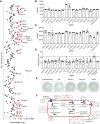An arrayed CRISPR screen of primary B cells reveals the essential elements of the antibody secretion pathway
- PMID: 36860866
- PMCID: PMC9969136
- DOI: 10.3389/fimmu.2023.1089243
An arrayed CRISPR screen of primary B cells reveals the essential elements of the antibody secretion pathway
Abstract
Background: Humoral immunity depends on the differentiation of B cells into antibody secreting cells (ASCs). Excess or inappropriate ASC differentiation can lead to antibody-mediated autoimmune diseases, while impaired differentiation results in immunodeficiency.
Methods: We have used CRISPR/Cas9 technology in primary B cells to screen for regulators of terminal differentiation and antibody production.
Results: We identified several new positive (Sec61a1, Hspa5) and negative (Arhgef18, Pold1, Pax5, Ets1) regulators that impacted on the differentiation process. Other genes limited the proliferative capacity of activated B cells (Sumo2, Vcp, Selk). The largest number of genes identified in this screen (35) were required for antibody secretion. These included genes involved in endoplasmic reticulum-associated degradation and the unfolded protein response, as well as post-translational protein modifications.
Discussion: The genes identified in this study represent weak links in the antibody-secretion pathway that are potential drug targets for antibody-mediated diseases, as well as candidates for genes whose mutation results in primary immune deficiency.
Keywords: ER associated degradation (ERAD); endoplasmic reticulum; humoral immunity; immunodeficiency; in vitro differentiation; plasma cell; unfolded protein response.
Copyright © 2023 Trezise, Kong, Hawkins, Herold, Willis and Nutt.
Conflict of interest statement
The authors declare that the research was conducted in the absence of any commercial or financial relationships that could be construed as a potential conflict of interest.
Figures




References
Publication types
MeSH terms
Substances
LinkOut - more resources
Full Text Sources
Miscellaneous

